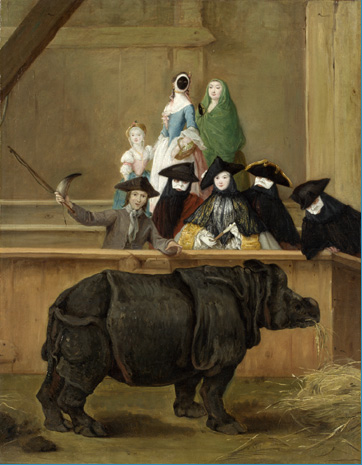With the carnival in Venice about to get underway this week’s picture is Pietro Longhi’s depiction of a group of Venetian revellers enjoying the unfamiliar spectacle of a captive rhinoceros. The painting, which was done in 1751, may be seen at the National Gallery in London.
A vivid description of carnival time in Venice was written by the seventeenth-century traveller and diarist John Evelyn. The festivities which he describes had changed little by the time Longhi was painting his picture:
“At Shrovetide all the world repair to Venice, to see the folly and madness of the Carnival; the women, men, and persons of all conditions disguising themselves in antique dresses, with extravagant music and a thousand gambols, traversing the streets from house to house, all places being then accessible and free to enter. Abroad, they fling eggs filled with sweet water, but sometimes not over-sweet. They also have a barbarous custom of hunting bulls about the streets and piazzas, which is very dangerous, the passages being generally narrow. The youth… contend in other masteries and pastimes, so that it is impossible to recount the universal madness of this place during this time of license.”
Around thirty thousand visitors descended on Venice for carnival, during which the wearing of a black or white mask guaranteed a welcome in most places. Evenings might be spent dancing, gambling or making amorous liasons, while in the daytime there were numerous entertainments to while away the hours: acrobatic displays; boxing and wrestling tournaments; ceremonial processions; or wild beast shows such as the one shown in the painting reproduced here. The artist’s interest seems evenly divided (like his composition) between the smallish, festively dressed carnival audience, safely ensconced behind a wooden barrier, and the mute, heavy-footed pachyderm standing in the arena before them.
Pietro Longhi spent...


